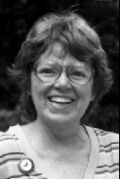Years ago, via one of those serendipitous moments the
universe occasionally hands you, I met a woman who influenced the rest of my
life. I was sitting in a library in San Miguel de Allende, Mexico, reading that
month’s issue of Ms. Magazine. A short letter to the Editor caught my eye: You
write about child labor as though it is a thing of the past, the writer said,
when farm labor currently uses children in the fields. Signed, Joan Papert
Preiss, Triangle Friends of the UFW. She must have given her address (this is
before things could be looked up on the Internet) because I wrote her and asked
if she needed help. “Yes,” she replied, and a few months later I was on a bus
to Durham, NC, ready to volunteer in her office, which happened to be in the guest
bedroom of her home.
Joan, as I learned at her memorial service last Saturday,
almost single-handedly brought farmworker activism (and attention to the plight
of farmworkers) to North Carolina. And she did so with a playful, creative
style. She became known as the lady with the tiaras, including a Mt. Olive
pickle jar headpiece that she wore to picket lines during the Mt. Olive boycott.
She made her own boycott lapel pins out of bake-able clay, and painted colorful signs and posters.
She also was known for wearing a grape costume that, I think, consisted mostly
of purple balloons during the UFW grape boycott.
She spoke fervently and persuasively about farm conditions to gatherings large and small, even though she admitted that she had once dreaded public speaking and still considered herself a shy person. Even in the face of circling policeman, angry store managers and apathetic
shoppers, she continued on with an unmitigated enthusiasm. I have never known
anyone who so exuded a persistent sense of purpose. After raising three sons,
she committed herself to the cause of farmworker rights. But she also
found time to cook gourmet meals, keep up an herb garden, hold girlfriend
get-togethers, go sailing, host sleepovers and playdates for her grandchildren,
volunteer at the local hospital, keep a materials/news file (now archived at Duke Library), and seriously
compete at badminton. And she found time to have fun with me when I was working with her. On one of my last days there, before I left to go back to
school, we decided spontaneously to have a “milkshake orgy”—and
so set about making shots of cranberry milkshakes, followed by pumpkin, peanut butter, etc., in her kitchen. Too full, we went
for a walk in Duke Forest, chatting and laughing together.
She offered me a blueprint for an active and happy life.
More importantly, she offered a level of acceptance and confidence in my
abilities that I’d never experienced before, at least from someone older than
me. What a gift knowing someone like that.
I often told her that I should write an article for Ms. about how we’d met, which would segue into an article about her
amazing life. Some of what I would have said is in this blog post now.
In another bit of serendipity, a bookend to the first, I was updating my list of
cell phone contacts recently and I saw her phone number, realizing I
hadn’t heard from her in a long while; the handmade holiday cards had stopped
coming a few years ago. With a sense of dread, I googled her name and found her
obituary. Without that bit of discovery I would have missed her memorial
service and a chance to say good-bye. We sang “Union Maid” and “De Colores” and
other songs, were reminded of how much she had meant to so many, and then dispersed
out into the hot afternoon.





